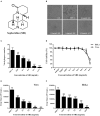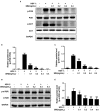Sophoridine Suppresses Herpes Simplex Virus Type 1 Infection by Blocking the Activation of Cellular PI3K/Akt and p38 MAPK Pathways
- PMID: 35756044
- PMCID: PMC9229184
- DOI: 10.3389/fmicb.2022.872505
Sophoridine Suppresses Herpes Simplex Virus Type 1 Infection by Blocking the Activation of Cellular PI3K/Akt and p38 MAPK Pathways
Abstract
Herpes simplex virus type 1 (HSV-1) is a ubiquitous and important human pathogen capable of causing significant clinical diseases ranging from skin damage to encephalitis, particularly in immunocompromised and neonatal hosts. Currently, widely used nucleoside analogs, including acyclovir and penciclovir, have some limitations in their use due to side effects and drug resistance. Herein, we report sophoridine's (SRI) dramatic inhibition of HSV-1 replication in vitro. SRI exhibited a remarkable inhibitory influence on HSV-1 virus-induced cytopathic effect and plaque formation, as well as on progeny viruses in Vero and HeLa cells, with selection indexes (SI) of 38.96 and 22.62, respectively. Moreover, SRI also considerably suppressed HSV-1 replication by hindering the expression of viral immediate-early (ICP0 and ICP22), early (ICP8 and TK), and late (gB and gD) genes and the expression of viral proteins ICP0, gB, and gD. We suggest that SRI can directly inactivate viral particles and block some stages in the life cycle of HSV-1 after adsorption. Further experiments showed that SRI downregulated the cellular PI3K/Akt signaling pathway and obstructed HSV-1 replication even more. Most importantly, SRI markedly repressed HSV-1-induced p38 MAPK pathway activation. Collectively, this natural bioactive alkaloid could be a promising therapeutic candidate against HSV-1 via the modulation of cellular PI3K/Akt and p38 MAPK pathways.
Keywords: HSV-1; PI3K/Akt pathway; antiviral; p38 MAPK pathway; sophoridine.
Copyright © 2022 Tang, Luan, Yuan, Sun, Rao, Wang, Liu and Zeng.
Conflict of interest statement
The authors declare that the research was conducted in the absence of any commercial or financial relationships that could be construed as a potential conflict of interest.
Figures








Similar articles
-
Wogonin inhibits in vitro herpes simplex virus type 1 and 2 infection by modulating cellular NF-κB and MAPK pathways.BMC Microbiol. 2020 Jul 28;20(1):227. doi: 10.1186/s12866-020-01916-2. BMC Microbiol. 2020. PMID: 32723300 Free PMC article.
-
Cepharanthine Suppresses Herpes Simplex Virus Type 1 Replication Through the Downregulation of the PI3K/Akt and p38 MAPK Signaling Pathways.Front Microbiol. 2021 Dec 9;12:795756. doi: 10.3389/fmicb.2021.795756. eCollection 2021. Front Microbiol. 2021. PMID: 34956164 Free PMC article.
-
BX-795 inhibits HSV-1 and HSV-2 replication by blocking the JNK/p38 pathways without interfering with PDK1 activity in host cells.Acta Pharmacol Sin. 2017 Mar;38(3):402-414. doi: 10.1038/aps.2016.160. Epub 2017 Jan 23. Acta Pharmacol Sin. 2017. PMID: 28112176 Free PMC article.
-
Penciclovir cream--improved topical treatment for herpes simplex infections.Skin Pharmacol Physiol. 2004 Sep-Oct;17(5):214-8. doi: 10.1159/000080214. Skin Pharmacol Physiol. 2004. PMID: 15452407 Review.
-
Resistance of herpes simplex viruses to nucleoside analogues: mechanisms, prevalence, and management.Antimicrob Agents Chemother. 2011 Feb;55(2):459-72. doi: 10.1128/AAC.00615-10. Epub 2010 Nov 15. Antimicrob Agents Chemother. 2011. PMID: 21078929 Free PMC article. Review.
Cited by
-
MiR-196a Promotes Lipid Deposition in Goat Intramuscular Preadipocytes by Targeting MAP3K1 and Activating PI3K-Akt Pathway.Cells. 2024 Aug 30;13(17):1459. doi: 10.3390/cells13171459. Cells. 2024. PMID: 39273029 Free PMC article.
-
Baicalin Inhibits FIPV Infection In Vitro by Modulating the PI3K-AKT Pathway and Apoptosis Pathway.Int J Mol Sci. 2024 Sep 14;25(18):9930. doi: 10.3390/ijms25189930. Int J Mol Sci. 2024. PMID: 39337417 Free PMC article.
-
Research progress of sophoridine's pharmacological activities and its molecular mechanism: an updated review.Front Pharmacol. 2023 Jun 16;14:1126636. doi: 10.3389/fphar.2023.1126636. eCollection 2023. Front Pharmacol. 2023. PMID: 37397472 Free PMC article. Review.
-
Antiviral Activity of Oridonin Against Herpes Simplex Virus Type 1.Drug Des Devel Ther. 2022 Dec 20;16:4311-4323. doi: 10.2147/DDDT.S387885. eCollection 2022. Drug Des Devel Ther. 2022. PMID: 36573068 Free PMC article.
-
Ribavirin inhibits peste des petits ruminants virus proliferation in vitro.Vet Med (Praha). 2023 Dec 26;68(12):464-476. doi: 10.17221/56/2023-VETMED. eCollection 2023 Dec. Vet Med (Praha). 2023. PMID: 38303996 Free PMC article.
References
LinkOut - more resources
Full Text Sources

